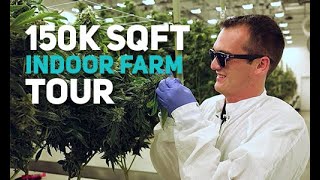Aeroponic Cannabis Farm Tour | Aeriz, Illinois
Aeroponic Cannabis Farm Tour | Aeriz, Illinois

Aeriz is a multi-state operator with cannabis cultivation locations in California, Arizona, and Illinois. Aeriz Illinois produces both medical and recreational cannabis.
Surna Cultivation Technologies is proud to have supplied Aeriz with their mechanical engineering design as well as climate control equipment including heat recovery chillers, fan coils, destratification fans, SentryIQ controls, and dehumidifiers.
TIMESTAMPS:
00:00 – Intro to Aeriz
00:25 – Meet Zack Bigg
00:44 – Meet Steve Bundy
00:54 – Controls and Irrigation Automation
01:19 – Propagation
02:07 – Veg
03:26 – Flower
03:51 – Drying
04:19 – Mechanical Room and HVAC Equipment
04:57 – SentryIQ Controls & Automation
05:37 – RO and Irrigation
06:30 – Advice for New Growers
06:48 – Outro
Contact Surna:
385 S. Pierce Avenue, Ste. C
Louisville, CO 80027
303-993-5271
info@surna . com
https://www.google.com/maps?cid=15600184408079160241
For Investors: investorrelations@surna . com
View more grow operation tours: https://www.youtube.com/playlist?list=PLY6gGmsAO7Sg8DU4jBJY_RP_WIpb-22GV
#surna $cead #surnacultivationtechnologies #cannabistour #cannabiscultivation #sentryiq #cannabisenvironments #growroomhvac #cannabistour2022

You use reverse osmosis water to ensure your nutrient ratio`s are not thrown off and yet thats exactly what you will get from a recirculating system. As the plants uptake elements the nutrient returned to the reservoir will have a completely different elemental profile. The beauty of aeroponics is that it uses so little water that you can run it drain to waste. This guarantees the plants receive the same optimal elemental profile of nutrient at each misting. A recirculated nutrient must have sufficient elemental capacity for the intended life of the reservoir, along with the additional buffering. No doubts the PH is controlled by dosers that add phosphoric acid which add to the problem by increasing the amount of phosphorus (P) in the nutrient. In short, a recirculated reservoir is not optimal even when it is freshly mixed and becomes increasing less optimal the longer it is in service.